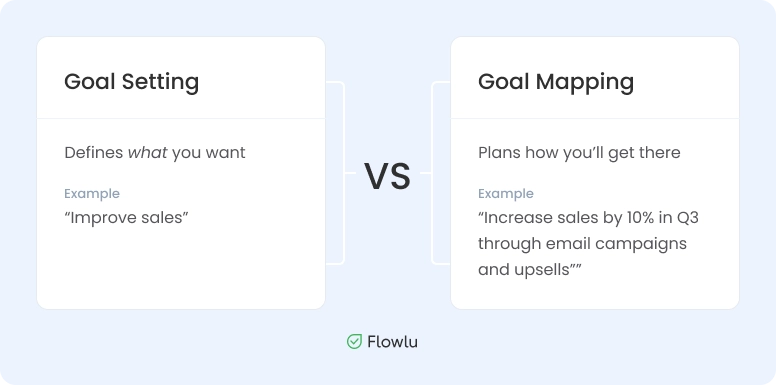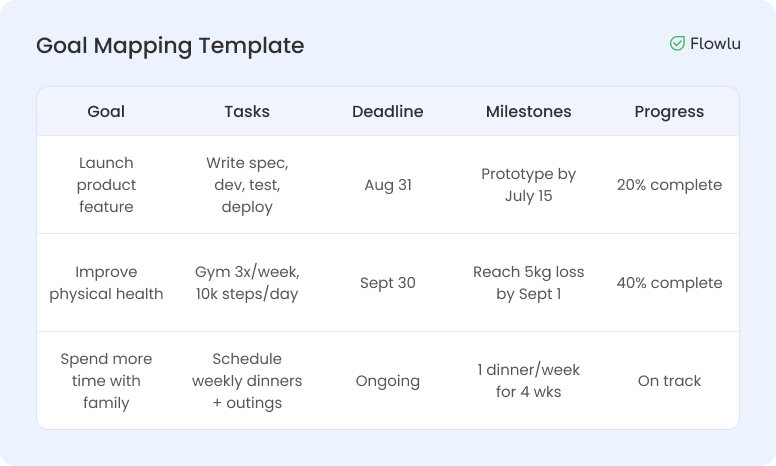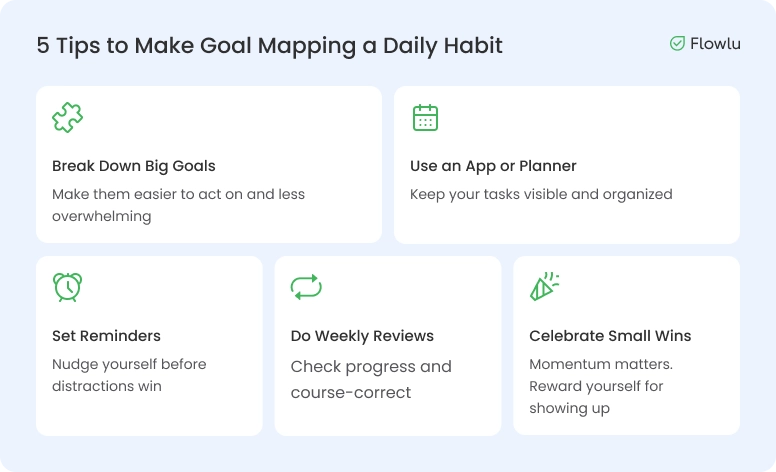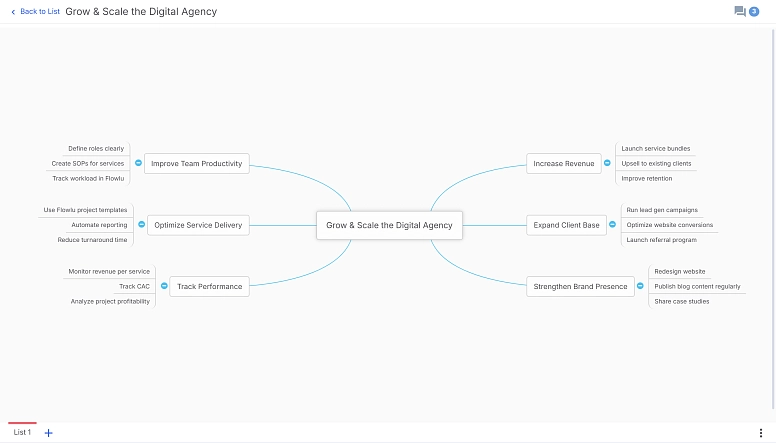Goal Mapping: What It Is and How to Create One That Works
As a business owner, it’s worth keeping goal maps on your radar. They give you a way to lay out what you want to achieve—and how you might actually get there. Of course, setting goals is one thing. But reaching them? That’s usually the hard part.
But goal setting isn’t just for work. It’s something we all need in our personal lives too. Maybe you’re trying to get healthier, organize your schedule, or just spend more time with your family. No matter the focus, having a clear plan helps.
That’s the idea behind goal mapping. You choose what matters, then figure out the steps. It’s a way to go from “I should do this” to “Here’s how I’ll actually do it.”
What Is a Goal Setting Map?
It’s a simple tool, really. Just a place to list your goals and the actions that support them. Could be a spreadsheet. Could be a sketch. Some people even map it out in a notes app. Doesn’t need to be fancy—just clear enough that it makes sense when you look back at it later.
Goal Mapping vs. Goal Setting: Not Quite the Same
These two terms get tossed around like they mean the same thing—but they’re not identical twins.
- Goal setting is deciding what you want.
- Goal mapping is figuring out how you’re going to get there.
You can think of it like this: goal setting is where you drop the pin. Goal mapping is everything that happens between here and there—the route, the turns, the checkpoints, and maybe a few unexpected detours.
4 Steps To Create A Goal Map
Step 1: Start With Your Strengths and Weaknesses
The first step, whether it’s for work or life, is to slow down and really assess what’s going on. What’s going okay? What’s kind of messy or stalled?
If it’s business-related, try breaking things into rough categories. Sales, money stuff, your team, maybe how you're running things day-to-day. Give each one a quick score, zero to five. Doesn’t have to be exact. If sales feels like one, that’s probably a place to focus. You don’t need to overthink it—just notice what feels off.
Step 2: Track Your Goals (and Their Progress)
Once you've defined your goals, don’t just let them float around in your head. Create a worksheet to track each one, including all the moving parts.
List out:
- The goal itself
- Key tasks to complete it
- Who’s involved (if anyone)
- Deadlines and checkpoints
- A space to measure progress along the way
The more detailed you are upfront, the easier it’ll be to stay accountable.
Step 3: Add a Timeline
Once you’ve got your goals down, try putting them on a timeline. Just list the steps in the order you’ll need to take them. Add a few points where you’ll stop and check in. These little checkpoints make a big difference—you’ll know if you’re moving or just spinning your wheels.
And honestly, seeing it all in front of you? That alone can help you stay focused. Plus, it feels good when you hit one of those marks.
Step 4: Review & Adjust Regularly:
Here’s the thing—your goal map isn’t going to stay perfect. And it shouldn’t. Life changes, priorities shift. That’s normal. Make it a habit to look at your map now and then. Some goals might not matter anymore. Others might need tweaking. If something’s off, fix it. No need to start over—just make a few changes and keep going.
Imagine you want to be at your best next summer, and you set a goal to lose 20 pounds. You define a specific timeframe to reach it. But once summer arrives, that goal either disappears—because you achieved it—or it evolves. Maybe now it becomes a “stay in shape” goal, so you don’t have to go through the same weight-loss effort again.
Goals shift, life happens, and your map should reflect that.
Try This: A Simple Goal Mapping Template
Not sure how to lay out your goal map? Here's what it might look like in action across different areas—personal and professional. You can use this structure to map your own goals, or tweak it to fit your workflow:
Goal Map Examples
As we mentioned earlier, you can create a goal map for your personal life, your business, or a mix of both. If this is your first time doing anything like this, it might feel hard to define your goals clearly. So, let’s start simple.
You might start with areas like these:
- Money goals – Maybe you want to stop living paycheck to paycheck. Or save for something specific. Or even just spend a bit less each week.
- Health goals – That could be sleeping better, moving more, or having energy that lasts past lunch.
- Family goals – Maybe it’s eating dinner together more often. Or less time on screens when you’re all in the same room.
- Personal growth – Could be learning something new, picking up an old interest again, or finishing that book you keep putting off.
But as you can see, these are still pretty general. The goal now is to shape those broad ideas into clear steps you can actually track. Let’s look at a few examples to get you going:
#1: Money Goals
Let’s say you’ve decided to focus on your financial health. You might set goals like:
- Reduce debt by 10% in the next 3 months
- Save 5% of your income each month
But goals alone aren’t enough—you also need actionable steps. For example:
→ Set up an automatic transfer to your savings account every payday.
#2: Health Goals
Want to focus on your health? It helps to turn that into a few clear, manageable habits.
- Go to the gym 3 times a week
- Walk 10,000 steps daily
- Establish a consistent bedtime
- Cut back on screen time before bedThese are measurable, realistic, and easy to track.
#3: Family Goals
If quality time with your family is the goal, here are a few things that could turn it into part of your routine:
- Plan one family outing per week
- Schedule two family dinners each week
Consistency here goes a long way.
#4: Personal Growth
Want to work on personal growth? You might start with goals like:
- Start a new hobby and stick with it 3 days a week
- Read a set number of books each month
These kinds of goals are great for building momentum—and they’re easy to build into your weekly routine
#5: Real-Life Goal Maps (Yes, They’re a Thing)
Goal maps aren’t just for solo use—they work for teams too. For example, let’s say a marketing team wants to increase newsletter sign-ups. Their goal map might look like this:
1. Goal: Increase newsletter signups by 30% in 60 days
2. Tasks:
- Launch a new lead magnet (Week 1)
- Run targeted ads (Weeks 2–8)
- Add newsletter prompt to blog pages (Week 3)
3. Milestones:
- 10% increase by week 3
- 20% by week 5
Mapping goals helps teams work better together and gives you a way to spot progress—or problems—early. The process works the same for one person or many: figure out your next steps, then get moving.
Why Goal Maps Sometimes Flop (and How to Avoid It)
Even with the best intentions, goal maps can fall apart. Here are a few common reasons—and how to avoid them:
Setting too many goals
When you treat everything as equally important, it becomes hard to give anything your full attention. Taking on too many goals at once usually means none of them get the focus they need. It's better to begin with a few that really matter and build from there.
Being too vague
“Get better at sales” sounds nice, but it’s not helpful unless you define what “better” actually means. Is it more closed deals? Higher conversion rates? Clear, detailed goals help you understand exactly what you're aiming for and how to move toward it.
Forgetting to review
A goal map isn’t something you set once and forget—it’s meant to evolve. If you’re not reviewing and adjusting it regularly, it’s like heading out on a road trip without ever checking the fuel gauge.
And if things start to feel off? You don’t need to start over. Just adjust the route. That’s how it’s supposed to work.
5 Tips to Integrate Your Goal Map into Your Daily Routine
So, you’ve got your goals written down. You’ve figured out how you want to reach them. Maybe you’ve even mapped it all out. That’s wonderful—but now comes the difficult part: working them into your day-to-day life.
At first, it might feel like too much. Honestly, that’s normal. But if you keep at it, even a little, it gets easier.
Here’s what can help:
1. Break Big Goals Into Pieces
Looking at a huge goal can be a bit much. It's easy to delay it. But if you split it up—just a few smaller tasks—it starts to feel doable. You’ll get things done and actually feel like you’re getting somewhere.
2. Use a Planner or App (Anything That Reminds You)
You don’t need anything complicated. Could be a notebook, a calendar app, whatever works. The point is to have a place that shows you what’s next.
It helps in two ways. One: you’re reminded of what you said you’d do. Two: it’s easy to spot what’s already done, and what’s still left.
Try checking in with it each morning. Take a quick look, shift things around if you need to, and move on with your day.
If you’re wondering what tools to try, here are a few:
- Notion or Trello – great if you prefer flexibility and visual layouts
- Google Sheets – perfect if you want to DIY your map
- Flowlu – ideal if you want task tracking, goal setting, and timelines in one place (see picture below)
- XMind or Miro – helpful if you’re more of a visual thinker who likes mind maps
3. Use Reminders
You probably already have a sense of what matters most—but even then, it’s weirdly easy to lose track of it once the day picks up. One meeting leads to another, and before you know it, the important stuff’s on the back burner again.
Reminders help. A phone alert, a little nudge from an app—something that pulls your attention back when things start to drift. Especially helpful for stuff you want to turn into a habit. Tiny thing, but it adds up.
4. Check In Once a Week
Goals shift. That’s normal. What felt urgent last week might not matter much now—and that’s why it helps to stop and check in regularly. Take a few minutes every week, even ten. Look over your map. What’s going fine? What’s dragging? Is anything off that you didn’t catch before? This isn’t about rewriting your whole plan. It’s more like adjusting the settings so things still feel doable.
5. Celebrate Small Wins
At the end of the day, check in with yourself. Maybe you didn’t finish everything. Still—if you showed up, stuck to something, or just made progress on a task you’ve been putting off, that’s worth noticing. These small wins matter. You’re building momentum. Quietly, but steadily.
Bottom Line
Goal mapping is simple, practical, and something anyone can do. In this article, we’ve walked through how to build a goal map, how to turn it into action, and how to keep it part of your routine. The rest is just practice.
Keep refining your goals, stick with your habits, and adjust as you go. That’s how real progress happens—one clear step at a time.
Want to Take It Further?
If you want to take your goal mapping a bit further, a few resources might come in handy:
- Atomic Habits by James Clear – helpful if you're working on small habits that add up to something bigger over time.
- Measure What Matters by John Doerr – a solid intro to OKRs (Objectives and Key Results) and how to use them without overcomplicating things.
- Canva or Miro goal planner templates – good option if you like dragging things around, adding color, or just thinking better with something visual in front of you.
Or skip the extras and build your own goal map based on what you’ve learned here. Start simple. Your future self will thank you.
Not really. One or two is fine if that’s what you’re ready for. The main thing is picking something that actually matters to you. No point writing down ten things you won’t look at again.
Yes, and it often should. This isn’t just for business goals. Want to walk more? Spend more time with your kids? Finally try painting? Same idea—map it out and make a plan.
Then change the plan. It happens. The goal you set last month might not make sense today. You can shift it, drop it, swap it—whatever fits better now. That’s part of the deal.
















